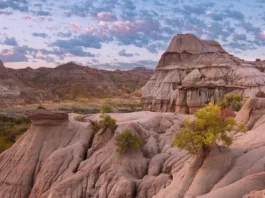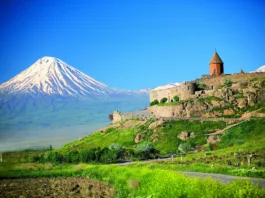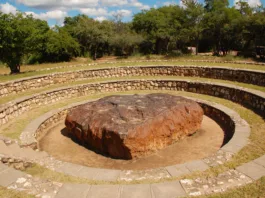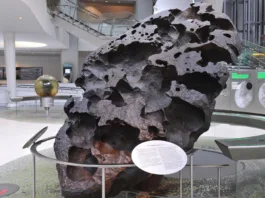Zhangye Danxia Landform, also known as Zhangye Danxia Geological Park or Rainbow Mountains, is a stunning geological wonder located in the province of Gansu, China. It is renowned for its unique and vibrant rock formations, which display a magnificent array of colors, resembling a vivid palette of a painter’s masterpiece.
This extraordinary landscape stretches across an area of approximately 510 square kilometers (197 square miles) and is part of the larger Zhangye National Geopark. The Danxia Landform is characterized by its towering cliffs, deep valleys, and steep, multicolored rock formations, which have been shaped by millions of years of geological processes.
The distinct coloring of the rocks is the result of various mineral deposits that have been exposed through erosion over time. Layers of different colored sandstone and minerals, such as iron and trace minerals, create a striking visual display of intense reds, oranges, yellows, greens, and blues. The interplay of light and shadows on these majestic formations adds to their surreal beauty, especially during sunrise and sunset.

Visitors to the Zhangye Danxia Landform can explore the park through a series of well-maintained boardwalks and viewing platforms. These vantage points offer panoramic views of the surrounding landscape, allowing visitors to marvel at the natural wonders and capture breathtaking photographs. The park also provides shuttle buses for convenient transportation within the site.
The Zhangye Danxia Landform has gained global recognition and has been listed as a UNESCO World Heritage Site. Its awe-inspiring beauty attracts tourists, photographers, and nature enthusiasts from around the world, who come to witness this geological phenomenon and immerse themselves in the stunning natural surroundings.
Beyond its scenic allure, the landform also holds significant scientific value. Geologists and researchers are drawn to the site to study its unique geological formations and unravel the mysteries of its creation. It serves as a living laboratory, providing valuable insights into the Earth’s geological history and the forces that shape our planet.
Zhangye Danxia Landform stands as a testament to the remarkable beauty and diversity found in nature. Its vibrant colors, dramatic landscapes, and geological significance make it a must-visit destination for those seeking a profound connection with the natural world and a captivating visual experience.

Contents
Formation of Zhangye Danxia Landform
The formation of the Zhangye Danxia Landform is a result of complex geological processes that have occurred over millions of years. The key factors contributing to its creation include tectonic activity, sedimentation, erosion, and weathering.
The region where the Zhangye Danxia Landform is located was once an ancient inland basin. About 100 million years ago, tectonic movements, including the collision of tectonic plates and the uplift of the Tibetan Plateau, began to shape the landscape. These movements led to the gradual uplift of the region, exposing the sedimentary rocks that were deposited over millions of years.
The rocks in the area consist mainly of sandstone and siltstone, which were formed through the accumulation of sand and mud in a marine environment. These sediments were subsequently compacted and cemented together over time, forming solid rock layers.
As the uplift continued, the exposed rock layers were subjected to various weathering processes. Rain, wind, and other natural forces began to erode the rocks, gradually sculpting them into the spectacular formations seen today. The rocks were particularly susceptible to erosion due to their composition, which included different minerals and pigments that gave rise to the vibrant colors.
One of the significant contributors to the unique colors of the Zhangye Danxia Landform is iron oxide. The iron in the rocks oxidized over time, resulting in the formation of iron oxide minerals, such as hematite, which gives the rocks their striking red color. Other mineral deposits, such as chlorite and goethite, contribute to the array of colors observed in the landform.
Erosion played a crucial role in shaping the landform’s distinct features. Water runoff from rainfall and melting snow carved deep valleys and gorges, exposing the layered rock formations. The differing resistance of the rock layers to erosion led to the formation of steep cliffs, pillars, and other intricate shapes.
The combination of tectonic uplift, sedimentation, weathering, and erosion processes over millions of years resulted in the breathtaking Zhangye Danxia Landform we see today. Its vivid colors, intricate patterns, and unique geological features make it a remarkable natural wonder and a testament to the Earth’s geological history.

Rock Types and Composition
The Zhangye Danxia Landform primarily consists of sedimentary rocks, with the most common types being sandstone and siltstone. These rocks have distinct characteristics and composition that contribute to the vibrant colors and unique formations of the landform.
- Sandstone: Sandstone is a sedimentary rock composed mainly of sand-sized mineral particles or grains. In the Zhangye Danxia Landform, the sandstone layers are predominantly formed by the accumulation and cementation of sand in a marine environment. The sand grains are typically composed of quartz, which gives the rocks their characteristic hardness and resistance to weathering.
- Siltstone: Siltstone is another common rock type found in the Zhangye Danxia Landform. It is a fine-grained sedimentary rock composed of silt-sized particles, which are smaller than sand particles but larger than clay particles. Siltstone is often found interbedded with sandstone layers, forming the distinctive stratified rock formations observed in the landform.
- Iron Oxide Minerals: One of the defining features of the Zhangye Danxia Landform is the presence of vibrant colors, primarily red, which are attributed to iron oxide minerals. The iron in the rocks oxidizes over time, leading to the formation of iron oxide minerals such as hematite. Hematite imparts the characteristic red color to the rocks, while other iron oxide minerals like goethite and limonite may contribute to the range of colors observed, including yellows, oranges, and browns.
- Other Trace Minerals: Apart from iron oxide minerals, the rocks of the Zhangye Danxia Landform may contain other trace minerals that contribute to the color variations and overall composition. These minerals can include chlorite, which adds shades of green, as well as carbonate minerals like calcite and dolomite, which may appear as white or light-colored patches within the rock layers.
The specific composition of the rocks in the Zhangye Danxia Landform, along with the varying concentrations of iron oxide and trace minerals, gives rise to the vibrant colors and intricate patterns observed in the landform. These geological characteristics make the landform a truly remarkable and visually captivating natural wonder.
Physical characteristics of the landform
The Zhangye Danxia Landform exhibits several distinct physical characteristics that contribute to its mesmerizing beauty. Here are some notable features:
- Vibrant Colors: The landform is renowned for its vibrant and diverse palette of colors. The rocks display a stunning array of hues, including deep reds, oranges, yellows, greens, and blues. These colors are a result of mineral deposits within the rock layers, particularly iron oxide and other trace minerals.
- Striated Rock Layers: The landform showcases well-defined layers of sedimentary rock, which have been sculpted and exposed through erosion. These layers appear as striking horizontal stripes on the cliffs and formations, providing a visual representation of the geological history of the area.
- Towering Cliffs and Pillars: The Zhangye Danxia Landform is characterized by towering cliffs and pillars that rise vertically from the ground. These natural formations are the result of differential erosion, where softer rock layers eroded more quickly than harder layers, creating steep cliffs and pillars of various shapes and sizes.
- Deep Valleys and Gorges: The landform features deep, narrow valleys and gorges that have been carved out by water erosion. The flowing water over millions of years has shaped the landscape, creating dramatic and picturesque scenes.
- Unique Rock Formations: The Zhangye Danxia Landform exhibits a variety of unique rock formations that captivate visitors. These formations include peaks, ravines, caves, arches, and other intricate shapes, which have been sculpted by the forces of weathering and erosion.
- Interplay of Light and Shadows: The angled surfaces of the rock formations and the varying textures create a dynamic interplay of light and shadows throughout the day. This adds depth and enhances the visual appeal of the landform, particularly during sunrise and sunset when the colors are accentuated.
- Large-scale Land Area: The Zhangye Danxia Landform covers an extensive area of approximately 510 square kilometers (197 square miles). This vast expanse provides visitors with ample opportunities to explore and discover the different facets of the geological wonder.
These physical characteristics collectively contribute to the unique and awe-inspiring beauty of the Zhangye Danxia Landform, making it a remarkable destination for nature enthusiasts, photographers, and anyone seeking to witness the wonders of the natural world.

Unique land features and shapes
The Zhangye Danxia Landform is renowned for its unique land features and shapes, which contribute to its distinctive and otherworldly appearance. Here are some of the remarkable land features found within the Zhangye Danxia Geological Park:
- Cliffs and Escarpments: The landform showcases towering cliffs and steep escarpments that rise vertically from the ground. These impressive rock faces often exhibit layered formations, revealing the geological history of the region.
- Pillars and Pinnacles: The landform is characterized by numerous pillars and pinnacles of various sizes and shapes. These freestanding rock formations stand tall and are sculpted into fascinating shapes, resembling towers, needles, and spires. They are the result of differential erosion, where softer rock layers erode faster than harder layers, leaving behind these striking features.
- Ravines and Gorges: Deep ravines and narrow gorges cut through the landscape, adding a sense of depth and grandeur to the landform. These geological formations have been carved out by the erosive forces of water over millions of years, resulting in dramatic and picturesque valleys.
- Caves and Archways: The Zhangye Danxia Landform is home to natural caves and archways that have formed through erosion. These hollowed-out spaces and intricate arch formations provide unique opportunities for exploration and photography.
- Terraced Formations: Some areas of the landform exhibit terraced formations, where the rock layers have eroded into stepped or stair-like structures. These terraces create a visually striking pattern, adding to the overall aesthetic appeal of the landscape.
- Tilted Rock Layers: The sedimentary rock layers in the Zhangye Danxia Landform often display tilting and folding, showcasing the dynamic geological forces that have shaped the area over time. These tilted rock layers create visually captivating patterns and add to the geological complexity of the landform.
- Interconnected Valleys and Basins: The landform comprises a network of interconnected valleys and basins, forming a maze-like landscape. These valleys wind through the vibrant colored rock formations, offering a sense of exploration and discovery to visitors.
The unique land features and shapes found within the Zhangye Danxia Landform contribute to its surreal and almost otherworldly appearance. The combination of towering cliffs, freestanding pillars, deep ravines, and intricate formations create a truly mesmerizing and unforgettable natural spectacle.

Importance and preservation
The Zhangye Danxia Landform holds significant importance both in terms of its natural and cultural value. Here are some key aspects of its importance and the efforts made for its preservation:
- Geological Significance: The landform provides valuable insights into the Earth’s geological history. The distinct rock layers, tilted formations, and erosional features offer a glimpse into millions of years of geological processes, aiding scientists and researchers in studying the Earth’s past.
- Biodiversity and Ecosystems: The Zhangye Danxia Landform supports a diverse range of plant and animal species. The unique rock formations and microhabitats within the area provide niches for various plants and wildlife. Preserving the landform helps protect these ecosystems and contributes to the overall biodiversity of the region.
- Cultural and Historical Heritage: The landform holds cultural significance for the local communities and has historical connections. It has been a source of inspiration for artists, poets, and writers throughout history. Preserving the landform helps maintain the cultural heritage associated with its beauty and uniqueness.
- Tourism and Economic Benefits: The Zhangye Danxia Landform has become a major tourist attraction, drawing visitors from all around the world. Tourism generates economic benefits for the local communities, creating employment opportunities and contributing to the regional economy.
To ensure the preservation of the Zhangye Danxia Landform, several measures have been implemented:
- UNESCO World Heritage Listing: The landform has been recognized as a UNESCO World Heritage Site, which brings global attention and protection to its unique features. The listing promotes international cooperation and efforts to safeguard the landform.
- Protected Areas and Regulations: The establishment of protected areas, such as the Zhangye National Geopark, helps regulate human activities and ensure sustainable tourism practices. Rules and guidelines are in place to prevent damage to the landform and its fragile ecosystems.
- Visitor Management: The authorities have implemented visitor management strategies to control the number of visitors, protect sensitive areas, and minimize human impact. Designated walking paths, viewing platforms, and shuttle services are provided to guide visitors and prevent unauthorized access.
- Environmental Conservation: Efforts are made to promote environmental conservation within the landform area. This includes waste management, preservation of water resources, and the promotion of eco-friendly practices among visitors and local communities.
- Scientific Research and Monitoring: Ongoing scientific research and monitoring programs help assess the health and changes in the landform, enabling better conservation strategies and understanding of its geological processes.
By recognizing the importance of the Zhangye Danxia Landform and implementing measures for its preservation, there is a concerted effort to balance tourism and conservation, ensuring that future generations can continue to appreciate and learn from this natural wonder.

Exploration and tourist activities
Exploration and tourist activities in the Zhangye Danxia Landform offer visitors a unique and immersive experience amidst its breathtaking natural beauty. Here are some popular activities that visitors can engage in:
- Scenic Walks and Hiking: The landform provides well-maintained walking paths and trails that allow visitors to explore its remarkable formations on foot. Scenic walks and hikes offer an up-close view of the vibrant rock formations, valleys, and cliffs, providing ample opportunities for photography and appreciating the intricate details of the landscape.
- Viewing Platforms and Panoramic Views: The landform features strategically located viewing platforms that offer panoramic views of the surrounding area. These platforms provide elevated vantage points from where visitors can marvel at the expansive landscape, capturing the vastness and vivid colors of the rock formations.
- Photography: The Zhangye Danxia Landform is a paradise for photographers due to its unique and vibrant rock formations. The interplay of light and shadows, especially during sunrise and sunset, enhances the visual appeal and offers excellent opportunities for capturing stunning photographs.
- Cultural Experiences: The landform area is not only rich in natural beauty but also has cultural significance. Visitors can explore nearby local villages, interact with the communities, and experience the traditional customs, cuisine, and art forms of the region, providing a well-rounded cultural experience.
- Nature Interpretation Centers and Exhibits: The Zhangye National Geopark offers nature interpretation centers and exhibits where visitors can learn about the geological processes, formation of the landform, and the unique flora and fauna found in the area. These educational facilities enhance the understanding and appreciation of the landform’s natural heritage.
- Outdoor Activities: In addition to exploring the rock formations, visitors can also participate in various outdoor activities such as bird watching, nature walks, and picnicking in designated areas. These activities allow for a closer connection with the natural surroundings and provide opportunities for relaxation and enjoyment.
- Guided Tours: Guided tours are available within the Zhangye Danxia Landform, providing informative commentary and ensuring a comprehensive understanding of the geological and cultural aspects of the area. Knowledgeable guides can offer insights into the landform’s formation, its significance, and its ecological importance.
It’s important for visitors to follow guidelines and regulations set by the park authorities to preserve the landform’s integrity and protect its delicate ecosystems. Responsible tourism practices, such as staying on designated paths, not littering, and respecting the local communities and their customs, help ensure the sustainable enjoyment of the landform for future generations.
FAQ
Where is the Zhangye Danxia Landform located?
The Zhangye Danxia Landform is located in the Gansu Province of China, near the city of Zhangye. It is situated in the northern foothills of the Qilian Mountains.
How was the Zhangye Danxia Landform formed?
The Zhangye Danxia Landform was formed through a combination of geological processes over millions of years. It involves the deposition of sedimentary rocks, tectonic uplift, erosion, and weathering. The unique rock formations and vibrant colors are a result of the presence of iron oxide minerals and the intricate interplay of erosion and deposition.
Why is the Zhangye Danxia Landform so colorful?
The Zhangye Danxia Landform is known for its vibrant colors, primarily shades of red, orange, and yellow. These colors are a result of the presence of iron oxide minerals, particularly hematite, in the rock layers. Over time, iron in the rocks oxidizes, leading to the formation of these colorful minerals.
Is the Zhangye Danxia Landform a UNESCO World Heritage Site?
Yes, the Zhangye Danxia Landform is a UNESCO World Heritage Site. It was inscribed on the list in 2010 as part of the “China Danxia” property, which includes several Danxia landform areas in China.
Can visitors explore the Zhangye Danxia Landform?
Yes, visitors can explore the Zhangye Danxia Landform. The Zhangye National Geopark has designated walking paths, viewing platforms, and guided tours that allow visitors to experience the beauty of the landform while ensuring its preservation. However, it’s important to follow park guidelines and regulations to minimize human impact on the fragile ecosystem.
When is the best time to visit the Zhangye Danxia Landform?
The best time to visit the Zhangye Danxia Landform is during spring (April to June) and autumn (September to October) when the weather is pleasant and the colors of the landform are particularly vibrant. Summer can be hot, and winter can be cold, so it’s advisable to check weather conditions before planning a visit.
Are there other attractions or activities near the Zhangye Danxia Landform?
Yes, there are other attractions and activities near the Zhangye Danxia Landform. The nearby city of Zhangye offers cultural sites, such as the Giant Buddha Temple and the Wooden Pagoda Temple. Visitors can also explore the Mati Temple Grottoes, ride camels in the Mingsha Mountain and Crescent Lake scenic area, and visit the Binggou Danxia Scenic Area.






